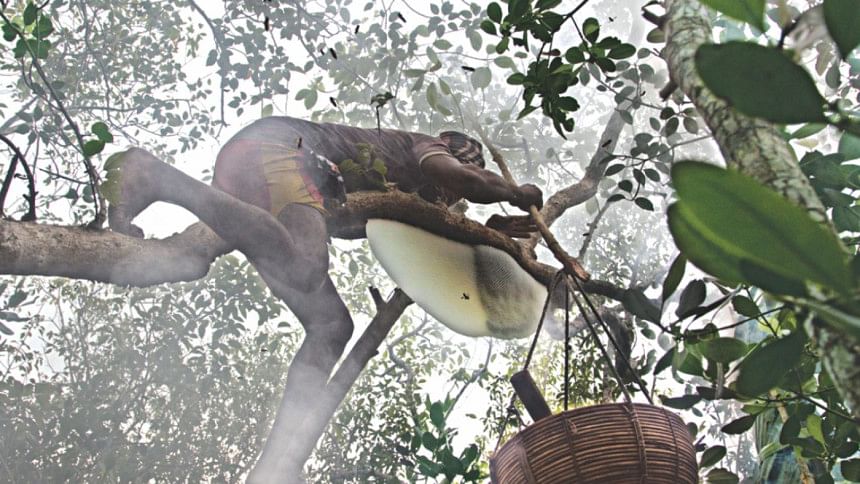Honey Hunting in Sundarban

Spring brings flowers to Sundarban. First to arrive are the flowers of Kholsha plants. Then Possur trees bloom. Finally the Goran trees' flowers appear. Many other plants also bloom - such as the beautiful purple Hargoza flowers - but these three flowers are special. They have nectar that bees collect.
Thus it is that every year over two hundred tons of honey (and a smaller amount of beeswax) is collected from the wild beehives of Sundarban. Since it is a reserve forest, honey-collection from the forest is by government permit. The honey hunting season officially opens on April 1.
The honey-hunters of Sundarban are called Moualis. Last week I joined a group of Moualis in their hunt for honey. This trip, offered by Bengal Tours, gave me an opportunity to see this activity up close.
We attended the formal inauguration in Burigoalini village along with Moualis and other villagers. Local leaders, honey experts and government officials spoke on forest- and honey-related matters. For example, sustainable collection of honey was emphasised. A Forest Department officer then handed passes to Moualis. Finally prayers were offered for their protection while in the forest.
A few hours later, our small boat came ashore on the forest. Stepping through deep mud, sticky and slippery, we followed the Moualis. Hetal and Hargoza plants, which looked so pretty from the boat, now placed thorns in our way. Low branches obstructed our progress. The tourists wore netting over their faces for protection; Moualis covered themselves with gamchas.
The Moualis were in form. This was their territory and they moved with easy speed. Preparing for the assault, they chopped Golpata leaves and tied them into bunches called Karu. These would be set on fire to create smoke which disperses the bees.
When we found a hive, a Mouali silently and cautiously climbed to a position to cut it. The swarm of bees covering the hive came alive forming a menacing cloud. While bee stings are not fatal, multiple stings of these giant bees can cause much pain, swelling, fever and diarrhoea. But the Karu worked like magic: bees flew away after buzzing angrily. The Mouali then sliced off parts of the hive and placed them in the collection basket, being careful to leave enough for re-generation. We left quickly before the bees returned for vengeance.
We retraced our steps through the mud to the boat. On-board, I broke off a piece of honeycomb containing honey. It tasted clean and refreshing, different from store-bought honey.
Then we were off to the next cutting. This one was harder. The ground was softer and more slippery, and the shoes dug in. We had to cross several streams. In one of them I mis-placed my leg and sunk to my hips in mud, which was fine, sticky and ash-coloured. Before the trip ended we had witnessed four cuttings.
I tried to imagine the tough life of the Moualis. During the season each collects perhaps 400 kg of honey per person, fetching around 40,000 to 60,000 taka. The rest of the time they fish or farm. While tigers are on their mind, their biggest threat, as their leader pointed out, is robbers who kidnap for ransom.
We made it without encountering tigers, being stung by bees or attacked by robbers. As for my few scratches of Hargoza thorns, I hung on to them as precious souvenirs of my adventure until they slowly faded. The memories however remained etched in my mind.
facebook.com/tangents.ikabir.

 For all latest news, follow The Daily Star's Google News channel.
For all latest news, follow The Daily Star's Google News channel. 



Comments